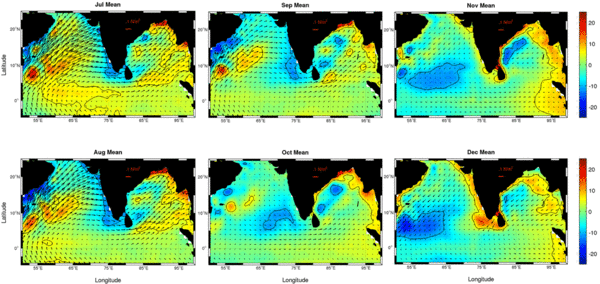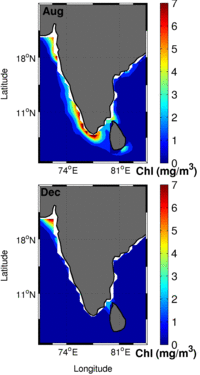Winds and currents around India
Image of the Month - December 2012

India has a climate much influenced by the ocean. The knowledge of currents (especially coastal ones), their intensity, direction, how they are generated (and when) is of foremost importance for the whole country.
The satellites show that upwelling occurs along the South West coast of India in May-September, as seen in the low sea level anomalies and the high average chlorophyll fields in August, disappearing by December.
Using the full nearly twenty-years time series of altimeter data, in correlation with model winds from ECMWF indicates that local/regional winds along western India are strongly correlated with the low SLA signal associated with upwelling in the West India Coastal Current. This suggests that local winds are more important than distant ones for this upwelling. In contrast, the strong downwelling signal (high coastal SLA) that develops in the West India Coastal Current during November-December is not correlated with the local-regional winds, originating instead along the Bay of Bengal coasts or Equator, which is consistent with previous studies.
The use of the 19-year time series gives us greater confidence in the results of the correlation analysis.
The continuity of the altimetry series of measurements, especially with the French-Indian SARAL satellites enable a better understanding, and thus potentially the forecasting of the ocean around India.
See also:
- Image of the Month, Oct. 2002: Summer current, winter current
- Image of the Month, Aug. 2004: Summer: wet monsoon season
References
- Dhage, L., T. Strub, T. Durland, R. Matano, Y. K. Somayajulu, 2012. A 20-Year satellite climatology of ocean circulation in the Northern Indian Ocean. Procedings of the 20-Years of Progress in Radar Altimetry Symposium, Venice, Italy.
- Rao, R.R., Girish Kumar, M.S., Ravichandran, M., Rao, A.R., Gopalakrishna, V.V. and Thadathil, P. (2010), Interannual variability of Kelvin wave propagation in the wave guides of the equatorial Indian Ocean, the coastal Bay of Bengal and the southeastern Arabian Sea during 1993-2006, Deep-Sea Res (114), I:57, 1-13





